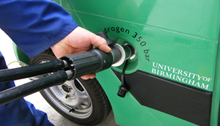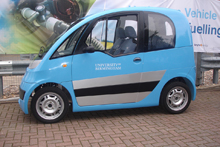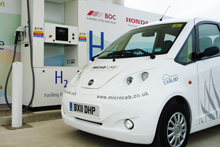Microcab's all new H2EV
 |
About the H2EVThe next-generation hybrid machine brings together expertise from the automotive and motorsport industries, incorporating a chassis designed by Delta Motorsport and Microcab and engineered by Lotus. For its power source the H2EV features a Horizon Fuel Cell Technologies system whose modules comprise the fuel cell, its control system and power-conditioning circuitry to charge the vehicle battery. This hybrid powertrain architecture combines the power capability of a Lithium-ion battery with the energy capability of a hydrogen fuel cell to achieve excellent vehicle performance with ultra-low energy usage and zero emissions. This four-seat, multi-purpose H2EV Microcab can be used as a car, a light van or a taxi, and has been designed to use either a hydrogen fuel cell powertrain or a pure battery EV drive, depending on the user's requirements and their access to refuelling infrastructure. That refuelling infrastructure has been strengthened with Coventry University’s new hydrogen fuel station. Microcab H2EV Vehicle Specification
|
 |
|
 |
|
 |
|
 |
|
 |
|
 |
|
 |
|
 |


 Microcab H2EV vehicles are able to refuel at hydrogen fillings stations at Birmingham (above top), Coventry (above), Loughborough (below) and, most recently, Swindon (below bottom).
Microcab H2EV vehicles are able to refuel at hydrogen fillings stations at Birmingham (above top), Coventry (above), Loughborough (below) and, most recently, Swindon (below bottom).
